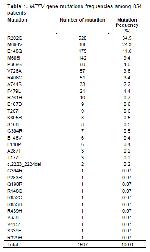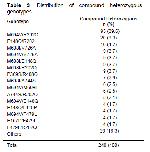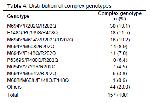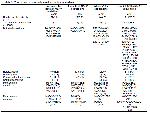Here, we reported the MEFV mutations reports of 1113 patients with clinical suspicion of FMF living in the northern Anatolia. We detected at least one mutation in 854 (76.7%) patients, and 31 different mutations were detected. 259 patients (23.3%) had no mutation. In other studies from Turkey, the prevalence of patients without mutations was in the range of 38.2-65.9%
11,13,14. The lower number of the patients without mutation in our study may be due to the high rate of consanguinity (31%) and we conducted a regional study from a single center.
FMF is a monogenic disorder inherited in the autosomal recessive manner. Although FMF is inherited autosomal recessively, some recent studies suggested that heterozygous people might manifest a spectrum of clinical features of mild and late-onset FMF. In several studies, as many as 30% of patients with FMF have only a single mutation in MEFV, even after whole exons sequencing. Partial penetrance and variable expressivity were suggested to explain the clinical features of FMF in heterozygous subjects 15,16. 46.1% of our patients with the clinical signs of FMF had heterozygous MEFV mutation.
In previous regional and country-wide studies from Turkey, R202Q, M694V, E148Q, M608I, V726A, and M694I were reported as the most common mutations 17,18. In this study, the most frequently observed mutations were R202Q, M694V, E148Q, M608I, P369S, and V726A. None of our patients had M694I mutation.
R202Q was the most common mutation (34.5%) in our study. R202Q was found in 5-34% of the Turkish population. Sayin et al. 19, Coskun et al. 20, Gumus et al. 11, Celep et al. 21 found the R202Q as the most common mutation. In some reports, it is still listed as a polymorphism and the clinical outcome of this alteration is not well defined. However, there were other studies accepted R202Q as a mutation with clinical significance. It was emphasized that homozygous or compound heterozygous R202Q mutations could cause the FMF phenotype 22. Arpacı et al. reported that R202Q, the clinical findings of the patients with R202Q mutation were similar to the diagnostic clinical findings of FMF reported in the literature, and all patients responded to colchicine treatment. They stated that R202Q may be a mutation rather than polymorphism and R202Q may be a risk factor in the development of the FMF clinic 23.
The G allele of R202Q was found in linkage disequilibrium (LD) with M694V, it means that certain alleles of each gene are inherited together more often than that would be accepted by chance 24. We found that in 179 alleles M694V and R202Q were in LD. Celep et. al showed LD between M694V and R202Q in 43 alleles 21. Kılınç et al. emphasized the frequent accompanying presence of M694V with R202Q and its clinical impact in their study 17.
M694V was the second most common mutation (24.3%) in our study. In the majority of the reports from Turkey, M694V was the most common mutation. Dogan et al. 25 Oztuzcu et al. 26, Barut et al. 27 reported M694V as a first common mutation with the frequency of 42.8%, 41.7%, and 41.1% respectively, whereas, in the study of Evliyaoglu et al. 28 M694V frequency was 3.2%.
In our study, E148Q was the third most common mutation (11.6%). It was reported as a third common mutation in Turkey with a frequency of 6.8% 8,19. It is found in 3-18% of the major ethnicities where FMF is common 2. The clinical significance of E148Q mutation is not well defined. It is considered as a polymorphism, and usually related with mild FMF phenotype 24.
P369S was the fifth common mutation (4%) in our patient group. This was the one of the major difference of our study from previous ones. Celep et al. 21 reported the allele frequency of P369S as 1.1% from the northern Anatolia. The allele frequency of P369S was 2.5% in the study of Gumus et al. 11.
M608I and V726A mutations were two of the common mutations in Turkish population 11. M608I frequency was reported in the range of 14.1-2.4% from previous studies 21. We found M608I as a fourth common mutation (9.4%). V726A frequency was reported in the range of 16.3-1.8 % from previous studies 21. V726A was the sixth common mutation (3.8%) in our study.
The majority of MEFV gene mutations responsible for the disease are missense mutations, whereas nonsense or deletion type mutations are rare 2. 29 (93.5%) of total 31 different mutations were missense mutations. Only 1 mutation was deletion type and 1 was a nonsense mutation.
When interpreting the mutation results of the patients, it is important to consider the method used for mutation detection. A number of methods are used in the diagnosis of FMF 17. In some studies, the patients were screened for the most common known mutations responsible for the majority of FMF, whereas some used sequencing of the gene. Some centers prefer sequencing only the exons coding the majority of disease-causing mutations, some others perform whole gene sequencing. Although the patient number was not homogenous, we saw that the method of exon 2,3,5 and 10 sequencing and whole gene sequencing revealed a more different number of mutations, more compound heterozygous and complex genotypes than the strip assay method. We also noticed that the most common mutations varied according to the method used to identify mutations. Gene sequencing either by the Sanger method or next-generation sequencing has the advantage to identify rare or novel variants, whereas interpreting the complex genotypes and novel variants may be difficult, and segregation analysis of the family is needed often.
In conclusion, our study revealed different results from the previous studies from Turkey. We had a high mutation detection rate in patients. P369S was the one of the commonest mutation in our study. According to the method used to detect MEFV gene variants, the frequencies of the mutations may vary in between the studies. The method should be in consider when giving genetic counseling to the families. We believe that our study may add some contribution to the mutational data of FMF.







